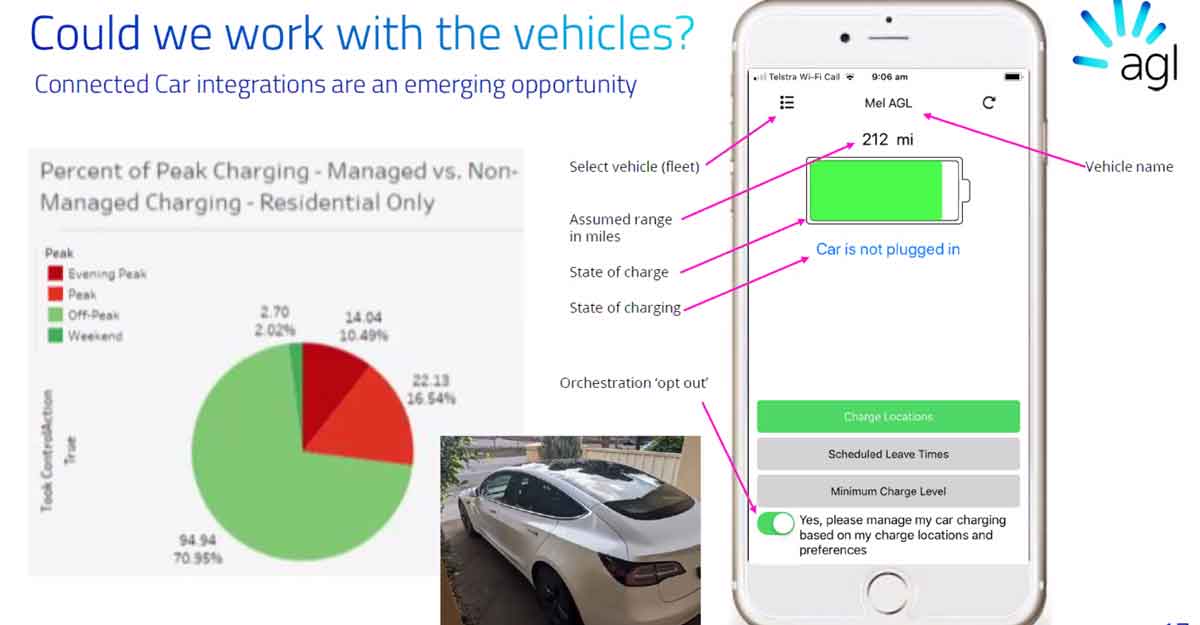Energy provider AGL wants you to be able to make money out of your car, while it is sitting at home in the garage.
Electric vehicles are now back on the whiteboard as part of the Coalition technology roadmap discussion paper on Thursday, but AGL’s EV strategy lead Kristian Handberg has been thinking about how electric cars will become part of everyday Australian lives for some four years now.
The impact that an increasing number of electric vehicles will have on the electricity grid is a real problem, but Handberg says it is also an opportunity.
Speaking in a webinar on Friday hosted by EV fleet management program Charge Together Fleets Evenergi and the Electric Vehicle Council, Handberg explained how amid the political maze that is electric vehicle policy, AGL is currently pushing to trial ways of managing the charging and discharging of electric vehicles using home-charging products that deliver benefits to the customer – namely, cold hard cash.
“We’re running a range of of initiatives at the moment within my portfolio of work and the first of those is at the pointy end of trying to solve the EV grid integration problem,” says Handberg.
“We’re negotiating with the Australian government for their support around a test of this orchestration – manage charging and discharging – using a range of different technologies in approaches and what we are trying to do is answer the key questions that relate to EV grid integration.
“Some of the analysis that you’ll see around speaks to the problem being felt most by the distribution networks and that is at the home charging level,” he says.
As electric vehicle uptake tends to occur in social clusters (the keeping up with the Jones’ effect), energy providers do not have visibility of the cars vehicles, which can have an adverse effect on the local grid.
“With distribution networks that is quite a hard challenge to solve,” says Handberg.
Handberg says that as part of a distributed energy grid (that is, the EV acts as a mobile battery that can charge a grid or home as well as store energy – known as vehicle-to-grid or vehicle-to-home), electric cars can actually help solve some of the issues around grid demand.
But to do that, consumers need to use wall chargers at home that can speak to the grid and the car. But according to Handberg, there is the little problem of getting drivers to buy them.
“One of the problems with home charging is that the customer doesn’t really see a lot of value in a dedicated charging solutio,n let alone one that’s networked as well,” he says.
“They tend to look at charging as a necessary evil, as far as they want the car but they’re not really after spending an extra 1500 bucks to get the charging solution.
“It is quite a challenge [to get consumers to install] a standard charging installation [let alone] a smart charging solution that would run to $1,500 to $2,000 in a home.”
“That’s pretty big expenditure …. no matter how you package it up there’s no free kicks, it still has to be paid for by somebody.”
Enter solutions like this “connected car” integration app. Handberg will be testing it with AGL customers to understand how it works and what they like and dislike about it.

“It could provide the foundations for a product solution and to solve energy market problems for different applications,” says Handberg.
According to Handberg, “this is what the energy system of the future is going to look like and what’s exciting about my opportunity at AGL is to be able to work in the test and design of that future system.”
By asking customers to use the app, AGL will be able to “see” electric vehicles as part of a distributed energy resource network.
“We are then able to monitor how the assets are operating, dynamically understand what’s going on and then potentially manage them, bid into the wholesale market and realise value from it.
For the consumer, it would mean money in the pocket. “We actually believe that will be paying customers,” says Handberg. “That’s a vision of the future that we are making happen right now.”
RenewEconomy and its sister sites One Step Off The Grid and The Driven will continue to publish throughout the Covid-19 crisis, posting good news about technology and project development, and holding government, regulators and business to account. But as the conference market evaporates, and some advertisers pull in their budgets, readers can help by making a voluntary donation here to help ensure we can continue to offer the service free of charge and to as wide an audience as possible. Thankyou for your support.

Bridie Schmidt is associate editor for The Driven, sister site of Renew Economy. She has been writing about electric vehicles since 2018, and has a keen interest in the role that zero-emissions transport has to play in sustainability. She has participated in podcasts such as Download This Show with Marc Fennell and Shirtloads of Science with Karl Kruszelnicki and is co-organiser of the Northern Rivers Electric Vehicle Forum. Bridie also owns a Tesla Model Y and has it available for hire on evee.com.au.


